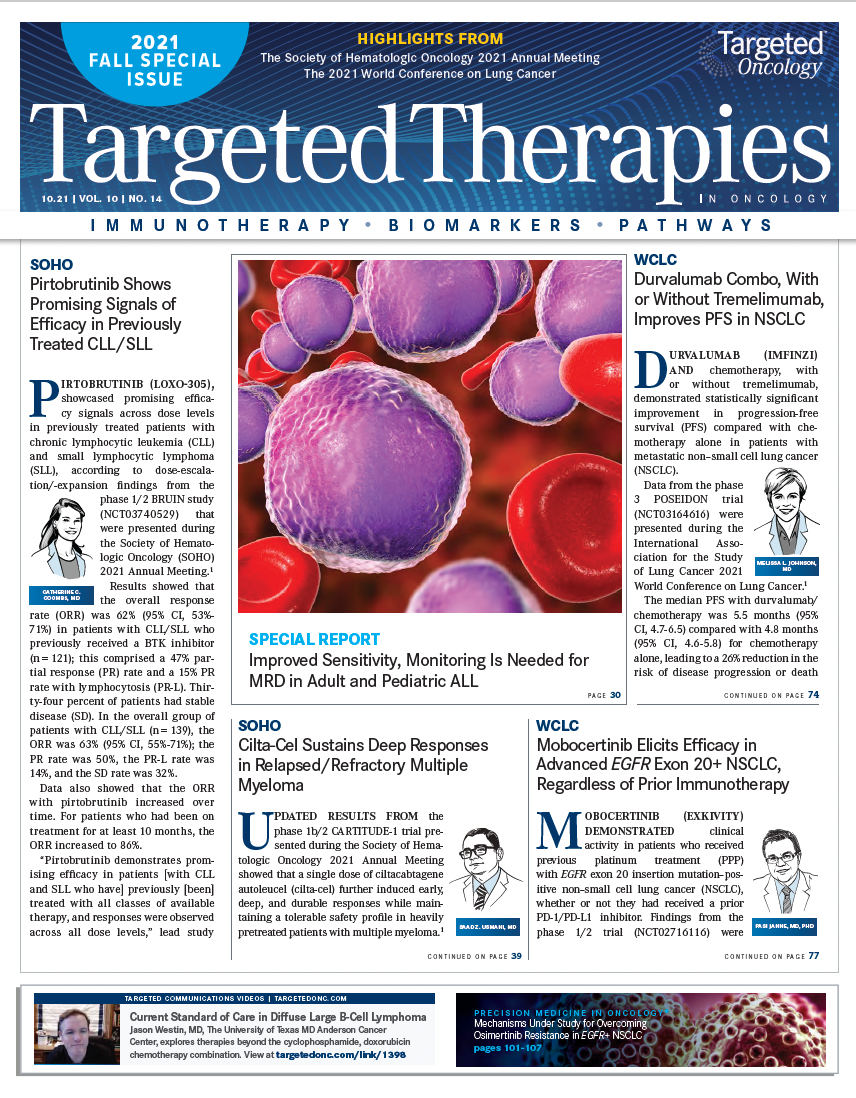Komrokji Discusses Using Hypomethylating Agents for Low- and High-Risk MDS
Investigators are looking into newer ways of using hypomethylating agents to treat patients with low-risk and high-risk myelodysplastic syndrome.
Rami Komrokji, MD

Myelodysplastic syndrome (MDS) is often treated with the hypomethylating agents (HMAs) azacitidine (Vidaza) and decitabine (Dacogen) in the higher-risk setting. However, these agents can also be used in patients with lower-risk disease in certain situations, and newer ways of using these HMAs are under investigation.
“They are the backbone for management of higher-risk MDS. The trials with azacitidine showed survival advantage,” Rami Komrokji, MD, vice chair of the Department of Malignant Hematology and head of the Leukemia and MDS Section at Moffitt Cancer Center in Tampa, Florida, said in an interview with the Targeted Therapies in Oncology.1
Azacitidine was the first drug the FDA approved for treating MDS in 2004; it can be used intravenously or subcutaneously. Decitabine also showed a survival advantage in patients with MDS and the agency approved it in this setting in 2006.2,3 Decitabine is typically used as an intravenous (IV) therapy, according to Komrokji.
Although these 2 therapies are the main treatments for high-risk MDS, “there are slight differences between azacitidine and decitabine and how they get incorporated in the cells,” Komrokji said. Azacitidine infiltrates the patient’s DNA and RNA, whereas decitabine only interacts with the DNA. Additionally, azacitidine is metabolized by the kidneys whereas decitabine is metabolized by the liver.
Komrokji said that compared with conventional therapies such as low-dose cytarabine, best supportive care, and chemotherapy, both agents demonstrated an approximate 50% overall response rate, 20% complete response rate, and an average duration of response of a year to a year and a half. The agents also showed a median survival of around 24 months in patients with high risk.
“But in real life, nobody has been able to duplicate that, so what we tell our patients is somewhere around a year and a half expected survival with those agents,” he explained.
For patients with intermediate- or high-risk MDS and chronic myelomonocytic leukemia (CMML), decitabine plus cedazuridine (Inqovi) is the first oral HMA approved as of 2020.4 “That will inhibit an enzyme called CDA; so it stabilizes decitabine so it’s not metabolized in the gut and can be absorbed,” Komrokji said.
In the trial (NCT02103478), patients either received 20 mg/m2 of IV decitabine or 35 mg of oral decitabine plus 100 mg of oral cedazuridine for the first cycle, then crossed over for the second cycle.5 For the third cycle, all patients received oral decitabine/cedazuridine. This trial showed similar efficacy and safety with the oral regimen compared with the IV decitabine. Komrokji thinks that this year more overall survival data will be available for the oral decitabine.
“It’s a nice option for the patients; it allows oral therapy [and avoids] a daily office visit, particularly in the COVID-19 era where patients were worried about coming to the office all the time,” Komrokji said.
The monitoring for the oral regimen is the same as the IV regimen, including weekly monitoring at the start of treatment because the patient’s blood counts tend to drop. The main difference is that the oral regimen can be taken at home. Oral decitabine/cedazuridine is used as a 3-day or 5-day regimen.
The oral decitabine regimen is included in the National Comprehensive Cancer Network guidelines, but Komrokji is worried that one challenge is that physicians are not comfortable adopting the regimen into their practice completely because they may need to get the patient to achieve response and then switch them to a different therapy.6 Moreover, copayments for oral regimens can be too expensive for patients if their insurance does not pay for it. “I think if patient insurance approves the drug and the patient is reasonable with follow-ups, oral decitabine is really equivalent to IV decitabine,” Komrokji said.
Other oral HMAs are also in development for MDS, such as oral azacitidine (Onureg; CC-486), which is approved in AML. Unlike oral decitabine, this oral regimen was not bioequivalent to the IV and subcutaneous regimens and so it is not interchangeable.
Oral azacitidine was tested in patients with lower-risk MDS, “but the dosing probably was not the ideal for lower-risk MDS,” Komrokji explained. AML maintenance therapy with oral azacitidine is 300 mg for 2 weeks and the dose tested in the lower-risk MDS trial (NCT01566695) was 300 mg for 3 weeks. Although there were some responses, there was also excessive toxicity of myelosuppression and febrile neutropenia.7 Until investigators find the appropriate dose, Komrokji said he discourages people from using the oral regimen in MDS.
For patients with high-risk MDS, Komrokji mainly uses the 7-day azacitidine regimen even though he feels that both azacitidine and decitabine are close to being equivalent. However, in patients with end-stage renal disease, he prefers decitabine because of how it is metabolized.
“There have been some data suggesting that decitabine may be more active in patients who have a TP53 mutation, a subtype of MDS that has poor prognosis. Also, outside of clinical trials, sometimes I will use decitabine,” he said. Beyond those 3 instances, he uses azacitidine in high-risk MDS because of the survival data in the AZA 001 trial (NCT00071799).8
In lower-risk MDS, azacitidine and decitabine are approved in the United States but not in Europe or Canada. For this patient population, HMAs reduce cytopenias, and are thus used in patients with low blood counts, and especially those with concomitant thrombocytopenia, neutropenia, and/ or anemia. Usually for low-risk disease, patients are given the 5-day regimen of azacitidine instead of the 7-day regimen after data showed that there was similar efficacy with less toxicity.9
“I typically restrict the use in the lower-risk setting for patients who have gone through other lines of therapy,” Komrokji said. “It’s not my first line after ESA failure, unless patients have concomitant thrombocytopenia and neutropenia that will limit my other choices of treatment.”
Usually, if a low-risk patient is eligible for lenalidomide, he will use that before either HMA unless there is thrombocytopenia or neutropenia. Both azacitidine and decitabine are reasonable options if the patient does not respond to lenalidomide. “Hopefully we’ll be able to confirm that maybe a shorter course of HMAs are OK in lower-risk MDS,” Komrokji said.
Recently, trials have looked at combination therapies using these HMAs as the backbone. This is especially important for patients who have progressed on HMAs previously. Doublet and triplet therapies using HMAs plus immune checkpoint inhibitors, BCL-2 inhibitors, targeted therapy, or immunotherapy are being investigated.10 Azacitidine has been combined with venetoclax (Venclexta), pevonedistat, nivolumab (Opdivo) or ipilimumab (Yervoy), magrolimab, and APR-246 (Eprenetapopt), among others, and shown varying degrees of efficacy.
References:
1. Kaminskas E, Farrell AT, Wang YC, Sridhara R, Pazdur R. FDA drug approval summary: azacitidine (5-azacytidine, Vidaza) for injectable suspension. Oncologist. 2005;10(3):176-182. doi:10.1634/theoncologist.10-3-176
2. Kantarjian H, Issa JPJ, Rosenfeld CS, et al. Decitabine improves patient outcomes in myelodysplastic syndromes: results of a phase III randomized study. Cancer. 2006;106(8):1794-1803. doi:10.1002/ cncr.21792
3. Saba HI. Decitabine in the treatment of myelodysplastic syndromes. Ther Clin Risk Manag. 2007;3(5):807-817. Accessed August 16, 2021. https://bit.ly/3yShnrT
4. FDA approves new therapy for myelodysplastic syndromes (MDS) that can be taken at home. News release. FDA. July 7, 2020. Accessed August 16, 2021. https://bit.ly/3xM4yxS
5. Garcia-Manero G, Griffiths EA, Steensma DP, et al. Oral cedazuridine/decitabine for MDS and CMML: a phase 2 pharmacokinetic/pharmacodynamic randomized crossover study. Blood. 2020;136(6):674- 683. doi:10.1182/blood.2019004143
6. NCCN. Clinical Practice Guidelines in Oncology. Myelodysplastic syndromes, version 3.2021. Accessed August 16, 2021. https://bit. ly/3g4EeJi
7. Garcia-Manero G, Santini V, Almeida A, et al. Phase III, randomized, placebo-controlled trial of CC-486 (oral azacitidine) in patients with lower-risk myelodysplastic syndromes. J Clin Oncol. 2021;39(13):1426-1436. doi:10.1200/JCO.20.02619
8. Fenaux P, Mufti GJ, Hellstrom-Lindberg E, et al; International Vidaza High-Risk MDS Survival Study Group. Efficacy of azacitidine compared with that of conventional care regimens in the treatment of higher-risk myelodysplastic syndromes: a randomised, open-label, phase III study. Lancet Oncol. 2009;10(3):223-232. doi:10.1016/ S1470-2045(09)70003-8
9. Lyons RM, Cosgriff TM, Modi SS, et al. Hematologic response to three alternative dosing schedules of azacitidine in patients with myelodysplastic syndromes. J Clin Oncol. 2009;27(11):1850-1856. doi:10.1200/JCO.2008.17.1058
10. Bewersdorf JP, Carraway H, Prebet T. Emerging treatment options for patients with high-risk myelodysplastic syndrome. Ther Adv Hematol. 2020;11:2040620720955006. doi:10.1177/2040620720955006

Survivorship Care Promotes Evidence-Based Approaches for Quality of Life and Beyond
March 21st 2025Frank J. Penedo, PhD, explains the challenges of survivorship care for patients with cancer and how he implements programs to support patients’ emotional, physical, and practical needs.
Read More